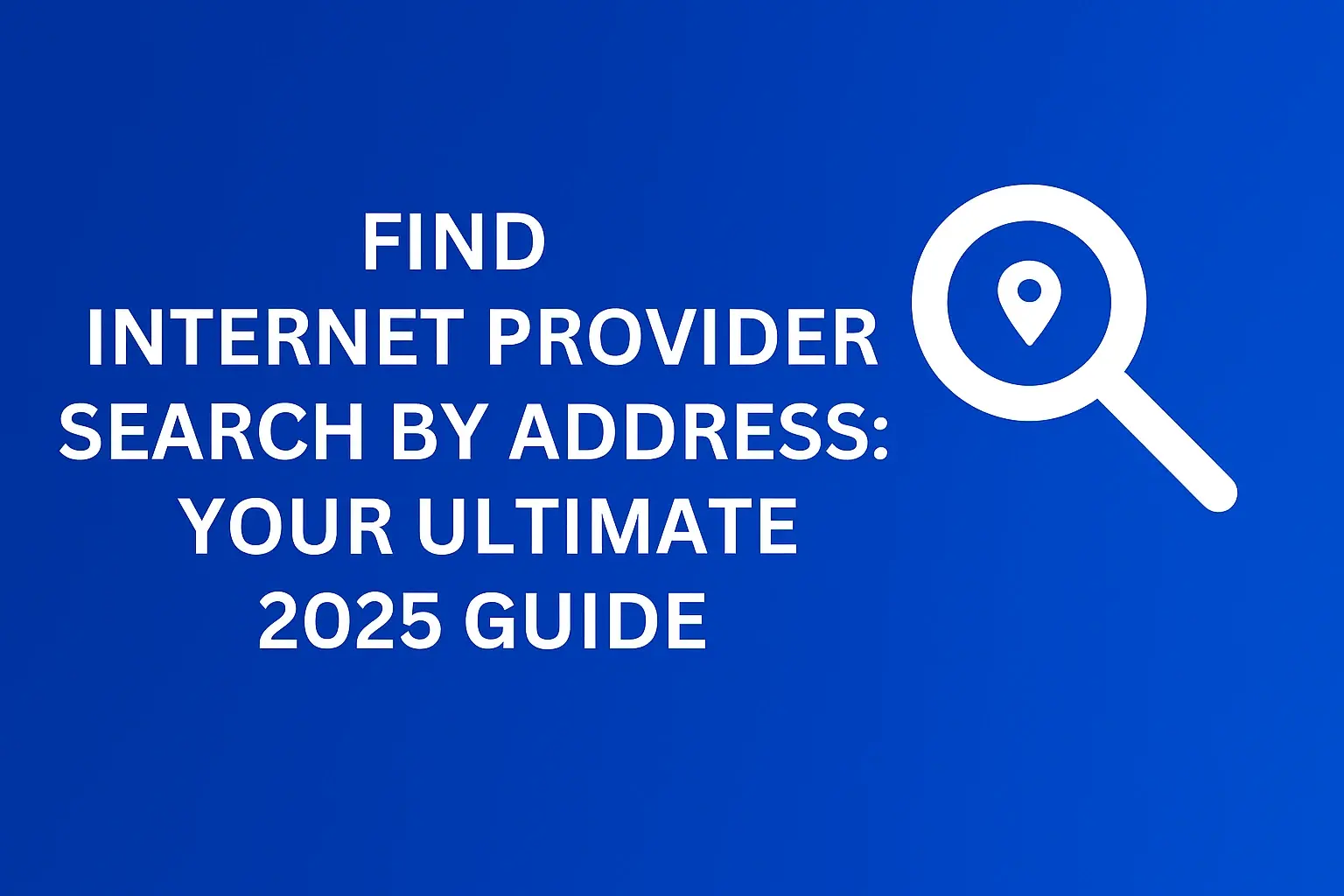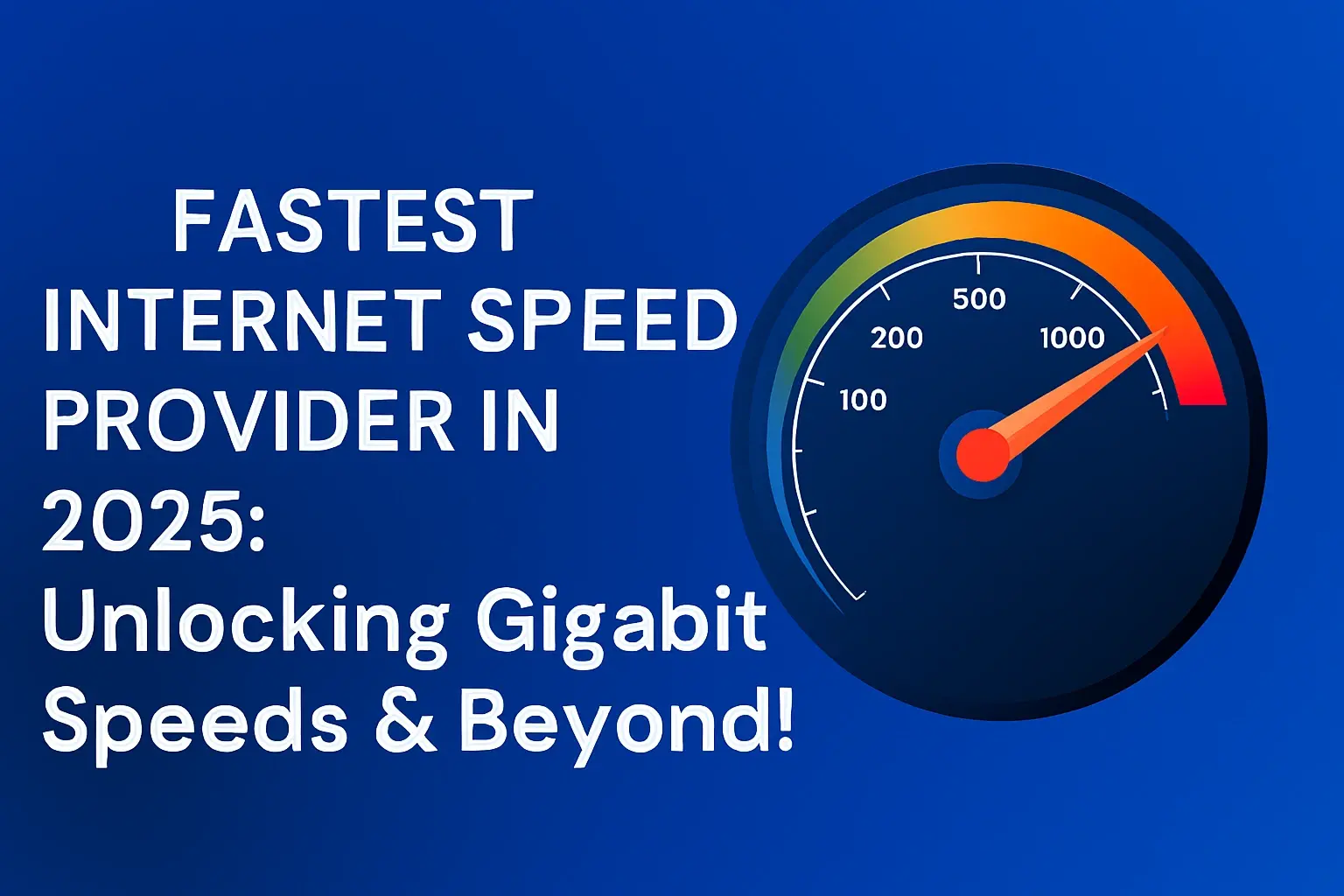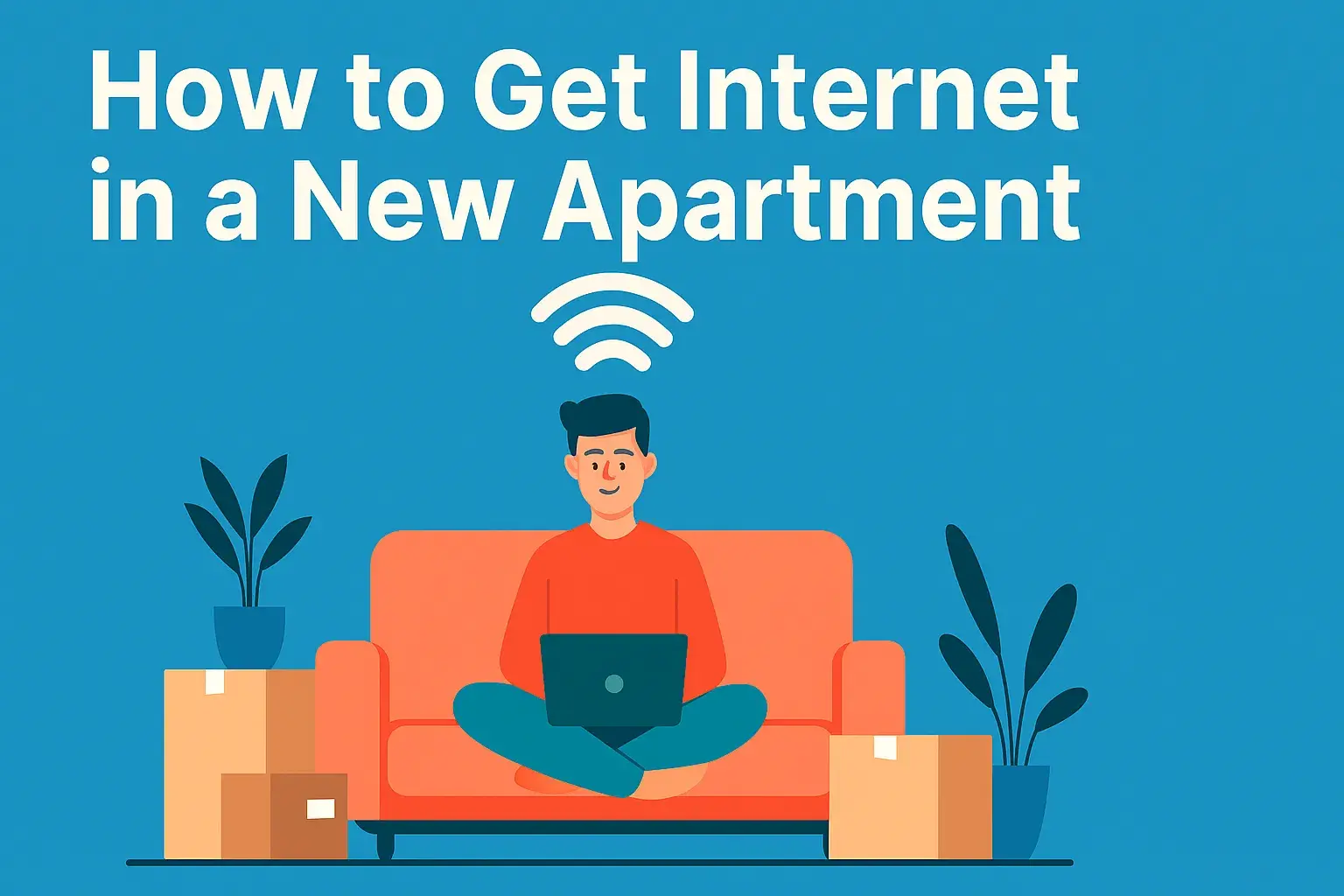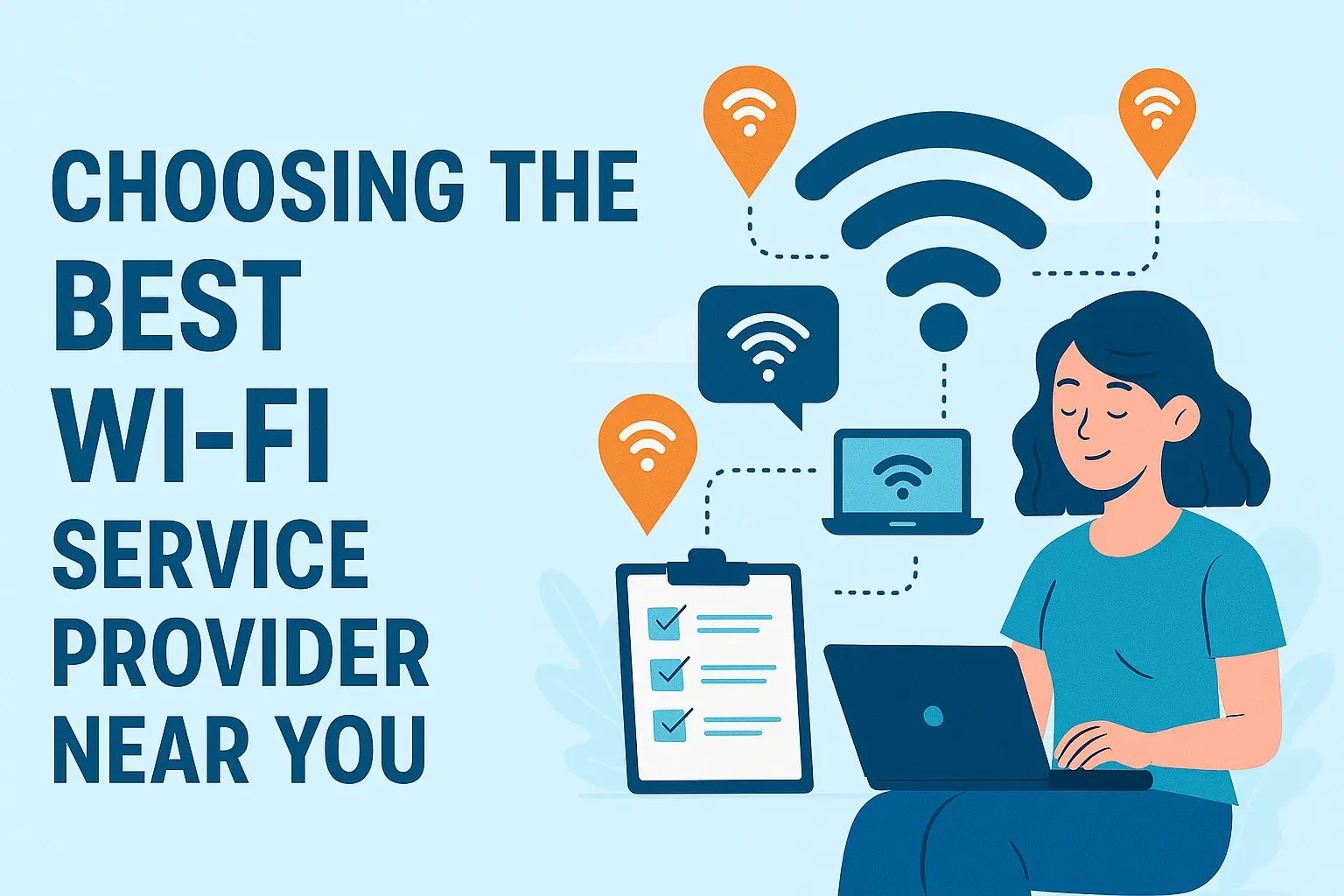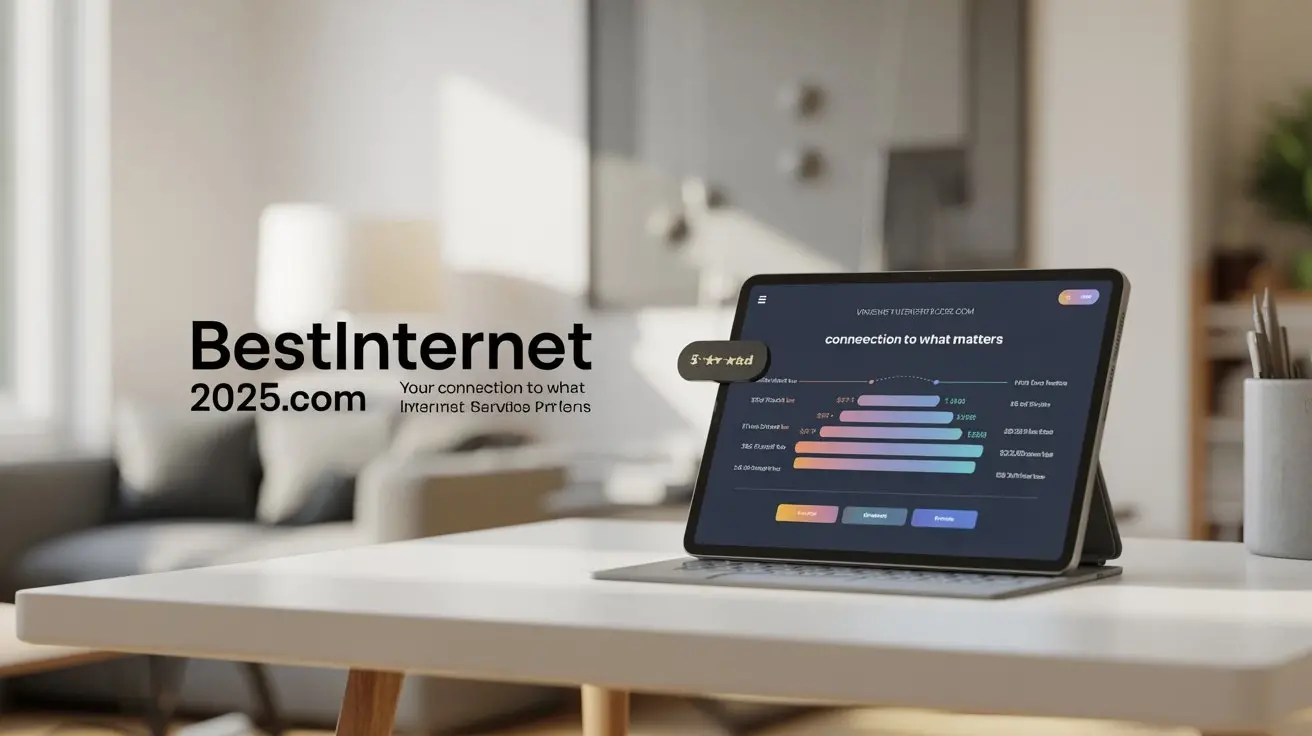Internet Provider for Address How to Choose the Best Option
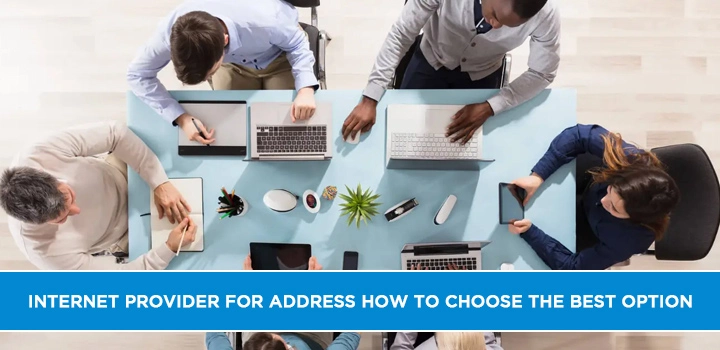
Finding the right internet provider for your specific address is crucial for seamless online living and working. This guide offers a comprehensive breakdown of how to navigate the options, compare services, and select the best internet solution tailored to your location and needs, ensuring you get speed, reliability, and value.
Understanding Your Internet Options
The digital landscape is constantly evolving, and so are the ways we connect to the internet. For many, the first step to securing reliable internet service is understanding the fundamental types of providers and technologies available. It's not a one-size-fits-all scenario; what works for one household might be entirely unsuitable for another. This section will demystify the common internet service providers (ISPs) and the foundational technologies they utilize, setting the stage for a more informed decision-making process. By the end of this section, you'll have a clearer picture of the broad categories of internet access you might encounter when searching for a provider at your specific address.
Major Types of Internet Service Providers
Internet Service Providers, or ISPs, are the companies that provide you with access to the internet. They act as the gateway between your home or business and the vast global network. The types of ISPs you'll encounter often correlate with the technology they employ. Generally, you'll find providers specializing in:
- Cable Internet Providers: These ISPs use the same coaxial cable network that delivers cable television. They are known for offering competitive speeds and are widely available in many urban and suburban areas.
- DSL Internet Providers: Digital Subscriber Line (DSL) internet uses existing telephone lines to transmit data. While it's a widely available technology, its speeds can be significantly slower than cable, especially over longer distances from the provider's central office.
- Fiber Optic Internet Providers: Fiber internet is the latest and often fastest technology, transmitting data via light signals through glass or plastic fibers. It offers incredibly high speeds and low latency, but its availability is still limited to specific areas where fiber optic networks have been laid.
- Satellite Internet Providers: For those in very remote or rural areas where terrestrial broadband is unavailable, satellite internet is often the only option. It works by transmitting data to and from a satellite orbiting Earth. While it offers broad coverage, it typically comes with higher latency, data caps, and slower speeds compared to other technologies.
- Fixed Wireless Internet Providers: This technology uses radio waves to connect a fixed location (like your home) to a nearby access point. It's a good option for areas where traditional wired infrastructure is lacking but is not as widespread as cable or DSL.
The Role of Your Address in Provider Selection
It's essential to understand that your physical address is the single most critical factor in determining which internet providers and technologies are available to you. ISPs invest heavily in infrastructure, and their network coverage varies dramatically from one neighborhood to the next, and even from one side of a street to the other. A provider that offers lightning-fast fiber optic internet in one town might not have any presence at all just a few miles away. Therefore, the process of finding the best internet provider for your address begins with a thorough check of what's actually offered in your specific geographic location.
This initial understanding of the different types of providers and the paramount importance of your address lays the groundwork for the subsequent steps in our guide. Without knowing what's physically possible for your location, any comparison of plans or features would be purely theoretical. The next section will guide you through the practical steps of discovering precisely which providers can serve your home.
How to Check Internet Provider Availability at Your Address
The most crucial step in selecting an internet provider is verifying which services are actually available at your specific address. This isn't a theoretical exercise; it's about concrete, location-based offerings. Many providers have extensive networks, but their infrastructure doesn't reach every single home. Fortunately, checking availability is a straightforward process, and doing it correctly will save you significant time and frustration. This section will walk you through the most effective methods to determine your internet provider options.
Online Availability Checkers
Most major ISPs provide tools on their websites to check service availability. This is usually the quickest and most direct method. You'll typically be asked to enter your street address, city, and ZIP code. Some tools may also ask for your apartment or unit number if you live in a multi-dwelling unit.
Steps to use online checkers:
- Visit the official website of an ISP you are interested in (e.g., Xfinity, Spectrum, Verizon Fios, AT&T Fiber, T-Mobile Home Internet, Starlink).
- Look for a section labeled "Check Availability," "Find Services Near You," or similar.
- Enter your full street address, including any apartment or unit number.
- Submit the form and review the results. The website should display which internet plans and technologies are available at your location.
It's advisable to check multiple ISPs this way, as different providers will have different coverage maps. Don't rely on just one company's website.
Third-Party Aggregator Websites
Numerous third-party websites specialize in aggregating internet provider information. These platforms allow you to enter your address once and then compare the offerings from multiple ISPs simultaneously. This can be a significant time-saver.
Benefits of aggregator sites:
- Convenience: Compare multiple providers in one place.
- Broader Scope: They often include smaller or regional ISPs that you might not have considered.
- Feature Comparison: Many sites offer side-by-side comparisons of speeds, prices, and features.
When using these sites, always double-check the information directly with the ISP if possible, as availability and pricing can sometimes have slight discrepancies.
Calling Providers Directly
If you're having trouble with online tools or want to speak with a representative, calling the ISP directly is an option. A customer service agent can often perform a more detailed check of your address, especially if you're in a complex or newly developed area.
When to call:
- If online checkers are inconclusive.
- If you live in a rural area or a new construction.
- If you have specific questions about installation or infrastructure that aren't clear online.
Be prepared to provide your full address and potentially your utility account number or other identifying information.
Checking with Neighbors and Local Resources
Sometimes, the best information comes from those who are already living in your neighborhood. Ask your neighbors which providers they use and what their experience has been. They can offer real-world insights into reliability and customer service that online tools can't provide.
Additionally, local community forums, social media groups, or even your local government's website might have information about available broadband services, especially in areas where new infrastructure projects are underway or in progress.
Understanding Availability Results
Once you've checked availability, you'll likely see a list of available technologies (DSL, Cable, Fiber, Satellite, Fixed Wireless) and the specific providers offering them. You might also see different speed tiers available within each technology. It's important to note that "available" doesn't always mean "optimal." For instance, DSL might be available, but its speeds might be too slow for your needs compared to cable or fiber, which might also be available.
The next crucial step is to understand what these different technologies and speed offerings mean for your daily internet usage. This leads us to the key factors you should consider when evaluating the options presented to you.
Key Factors to Consider When Choosing an Internet Provider
Once you've identified the internet providers available at your address, the next step is to critically evaluate their offerings. Simply picking the first one you see or the cheapest option might lead to dissatisfaction down the line. A thorough evaluation involves considering several key factors that directly impact your online experience. This section will delve into these crucial elements, helping you make a well-informed decision that aligns with your needs and budget.
Speed Requirements (Download and Upload)
Internet speed is often the most talked-about feature, but it's important to understand what speeds you actually need. Speeds are measured in megabits per second (Mbps). There are two key types of speeds:
- Download Speed: This is how quickly you can receive data from the internet. It's crucial for streaming videos, downloading files, browsing websites, and video conferencing.
- Upload Speed: This is how quickly you can send data to the internet. It's important for uploading files to cloud storage, posting photos or videos online, playing online games, and conducting video calls where your camera is active.
General Speed Recommendations for 2025:
- Basic Browsing & Email: 25-50 Mbps download.
- Streaming HD Video (1-2 devices): 50-100 Mbps download.
- Streaming 4K Video, Online Gaming, Multiple Devices: 100-300 Mbps download.
- Heavy Usage (large file uploads/downloads, multiple 4K streams, smart home devices): 300+ Mbps download.
- Upload Speed: While download speeds are often prioritized, adequate upload speeds are becoming increasingly important. For most households, an upload speed that is at least 10-20% of your download speed is usually sufficient. However, if you frequently upload large files or conduct professional video conferencing, you might need upload speeds of 50 Mbps or higher.
Consider the number of devices connected simultaneously and the primary activities performed on your internet connection when determining your speed needs.
Data Caps and Unlimited Data Plans
Data caps are limits on the amount of data you can download and upload within a billing cycle. Exceeding these caps can result in extra charges or a significant reduction in speed. In 2025, data caps are still prevalent, especially with satellite and some fixed wireless providers, and can also appear on certain cable or DSL plans.
Understanding Data Caps:
- Typical Caps: Can range from 100 GB to 1 TB (1000 GB) or more.
- Consequences of Exceeding: Overage charges (can be expensive) or throttled speeds (making the internet unusable for streaming or browsing).
- Who Needs Unlimited Data: Households that stream a lot of video (especially 4K), frequently download large files, play online games extensively, or have many connected smart home devices.
Many providers now offer unlimited data plans, often as a premium option. If you're a heavy internet user, an unlimited plan is almost always worth the extra cost to avoid unexpected bills and ensure consistent performance.
Contract Lengths and Early Termination Fees (ETFs)
Be aware of the contract terms offered by ISPs. Many providers require customers to sign a 12-month or 24-month contract. While these contracts can sometimes offer lower introductory pricing, they often come with significant Early Termination Fees (ETFs) if you decide to switch providers before the contract ends.
Considerations:
- Flexibility: Month-to-month plans offer more flexibility but may have higher regular pricing.
- ETFs: Understand the exact amount of the ETF and how long you are committed. Some providers may waive ETFs if you move to a new location within their service area.
- Introductory Offers: Be mindful of how long promotional pricing lasts. After the introductory period, the price often increases significantly.
For those who value flexibility or are unsure about their long-term needs, a no-contract option is preferable, even if it means a slightly higher monthly bill.
Installation Fees and Equipment Costs
Beyond the monthly service fee, ISPs often charge for installation and equipment. Installation fees can range from $0 to over $100, depending on the provider and the complexity of the setup. Equipment costs can also add up; you might need to rent a modem and router from the ISP for a monthly fee, or you may have the option to purchase your own compatible equipment.
Tips for managing costs:
- Negotiate Installation Fees: Sometimes, ISPs will waive installation fees as a promotional offer or if you book an appointment during a less busy period.
- Use Your Own Equipment: Purchasing your own modem and router can save you money in the long run, as rental fees can add up quickly. Ensure the equipment you buy is compatible with the ISP's network.
- Bundling: While not always the cheapest option, bundling internet with TV or phone services can sometimes lead to discounts.
Always clarify all potential upfront costs before signing up.
Promotional Pricing vs. Regular Pricing
Many ISPs lure new customers with attractive introductory offers and promotional pricing. While these deals can provide significant savings for the first few months or a year, it's crucial to understand the regular price of the service after the promotion ends. Some providers may increase the monthly rate by $20-$50 or more once the promotional period is over.
How to navigate pricing:
- Ask for the "Everyday Price": Inquire about the standard rate after the promotion expires.
- Read the Fine Print: Understand all terms and conditions related to pricing.
- Budget Accordingly: Plan your monthly budget based on the regular price, not just the introductory offer.
Being aware of these pricing structures will help you avoid sticker shock and make a sustainable choice for your budget.
Comparing Internet Plans: Speed, Data, and Pricing
With the key factors identified, it's time to dive into the specifics of comparing internet plans. This involves a detailed look at the speed tiers, data allowances, and pricing structures offered by the providers available at your address. A systematic comparison will help you identify the plan that offers the best value and performance for your household's unique needs. In 2025, the market offers a diverse range of options, making careful comparison more important than ever.
Understanding Speed Tiers and What They Mean
Internet providers typically offer multiple speed tiers for each technology they support. For example, a cable provider might offer plans at 100 Mbps, 300 Mbps, 500 Mbps, and 1 Gbps (1000 Mbps). Understanding what these speeds translate to in real-world usage is critical.
Example Comparison (Hypothetical 2025 Data):
| Plan Speed (Download) | Typical Use Cases | Number of Devices Supported | Estimated Monthly Price Range (USD) |
|---|---|---|---|
| 50 Mbps | Basic browsing, email, streaming SD video on 1-2 devices. | 1-3 devices | $40 - $60 |
| 100 Mbps | Streaming HD video on multiple devices, light online gaming, video calls. | 3-5 devices | $50 - $70 |
| 300 Mbps | Streaming 4K video, heavy online gaming, multiple simultaneous users, large file downloads. | 5-8 devices | $60 - $80 |
| 500 Mbps | Demanding 4K streaming, professional online gaming, extensive smart home integration, fast large file transfers. | 8-12+ devices | $70 - $90 |
| 1 Gbps (1000 Mbps) | Extreme bandwidth needs, simultaneous 4K streaming on all devices, professional content creation, multiple users with high demands. | 15+ devices | $80 - $120+ |
Note: Prices are estimates and vary by provider, location, and current promotions. Upload speeds are often significantly lower for cable and DSL compared to download speeds. Fiber plans typically offer much higher symmetrical upload speeds.
Data Allowance vs. Unlimited Data
As discussed earlier, data allowances are a critical factor. When comparing plans, pay close attention to the data cap, if any.
Scenario 1: Provider A (Cable)
- Plan: 300 Mbps download / 20 Mbps upload
- Data Cap: 1 TB (1000 GB) per month
- Price: $70/month (after 12-month promo)
- Consideration: If your household streams a lot of 4K content, you could approach or exceed 1 TB per month. A typical 4K movie stream can use up to 7 GB per hour.
Scenario 2: Provider B (Fiber)
- Plan: 500 Mbps download / 500 Mbps upload
- Data Cap: Unlimited
- Price: $85/month (no promo, but consistent price)
- Consideration: Offers peace of mind for heavy users and significantly faster upload speeds for content creators or those with frequent large uploads.
For most users in 2025, opting for unlimited data, if available and affordable, is a wise choice to avoid potential issues.
Bundling Services: Pros and Cons
Many ISPs offer bundles that combine internet, TV, and phone services. These bundles can sometimes offer a lower overall monthly cost compared to subscribing to each service separately.
Pros of Bundling:
- Cost Savings: Often cheaper than individual services.
- Convenience: One bill, one point of contact for multiple services.
- Promotional Offers: Bundles can come with attractive introductory discounts.
Cons of Bundling:
- Less Flexibility: You might be locked into services you don't fully use or need.
- Price Increases: Promotional pricing on bundles can expire, leading to higher costs.
- Service Quality Trade-offs: If one service in the bundle is poor (e.g., unreliable TV), you might be hesitant to switch even if the internet is good.
Carefully evaluate if you truly need all the services in a bundle before committing. Sometimes, getting the best internet from one provider and the best TV from another can be more cost-effective and satisfactory.
Hidden Fees and Fine Print
It's crucial to scrutinize the fine print of any internet plan. Beyond monthly fees, look out for:
- Activation Fees: A one-time charge for setting up your service.
- Equipment Rental Fees: Monthly charges for modems and routers.
- Taxes and Surcharges: These can add a significant amount to your monthly bill.
- Price Increases After Promotion: As mentioned, understand the regular rate.
- Service Call Fees: Charges for technician visits if issues arise.
Always ask for a clear breakdown of all potential charges before signing any agreement.
Understanding Different Internet Technologies
The type of internet technology available at your address significantly dictates the speed, reliability, and cost of your service. In 2025, while fiber is leading the pack, other technologies still play vital roles, especially in areas where fiber infrastructure is not yet present. Understanding the nuances of each technology will empower you to make the most informed choice based on your location and needs. This section breaks down the most common internet technologies you'll encounter.
Fiber Optic Internet
Fiber optic internet is considered the gold standard for broadband connectivity. It uses thin strands of glass or plastic to transmit data as pulses of light. This technology offers unparalleled speed and reliability.
Pros:
- Extremely High Speeds: Often offers symmetrical download and upload speeds, reaching 1 Gbps and beyond.
- Low Latency: Ideal for online gaming, video conferencing, and real-time applications.
- Reliability: Less susceptible to interference from weather or electrical signals compared to other technologies.
- Future-Proof: Capable of supporting future bandwidth demands.
Cons:
- Limited Availability: Requires extensive and costly infrastructure, so it's not available everywhere, especially in rural areas.
- Potentially Higher Cost: While prices are becoming more competitive, fiber plans can sometimes be more expensive upfront.
2025 Availability Snapshot: Fiber deployment continues to expand rapidly, particularly in urban and suburban areas. However, rural penetration remains a challenge.
Cable Internet
Cable internet utilizes the same coaxial cable network that delivers cable television. It's one of the most common and widely available broadband technologies in the United States.
Pros:
- Good Speeds: Offers competitive download speeds, often reaching hundreds of Mbps, and is readily available.
- Widely Available: Most urban and suburban homes have access to cable internet.
- Relatively Affordable: Often provides a good balance of speed and cost.
Cons:
- Shared Bandwidth: Speeds can fluctuate during peak usage times as bandwidth is shared among users in a neighborhood.
- Lower Upload Speeds: Upload speeds are typically much slower than download speeds.
- Data Caps: Many cable providers impose data caps.
2025 Availability Snapshot: Cable remains a dominant force, offering reliable service to a vast majority of the population. Providers are continuously upgrading their networks to offer higher speeds.
DSL (Digital Subscriber Line) Internet
DSL internet uses existing copper telephone lines to provide internet access. It's a legacy technology that is still available in many areas, particularly where other broadband options are scarce.
Pros:
- Wide Availability: Accessible anywhere there's a traditional phone line.
- Consistent Speeds (over short distances): Speeds are generally more consistent than dial-up.
- Often Cheaper: Can be a more budget-friendly option.
Cons:
- Slow Speeds: Significantly slower than cable or fiber, especially for downloads.
- Distance Dependent: Speeds decrease dramatically the farther you are from the provider's central office.
- Limited for Modern Use: Often insufficient for streaming 4K video, heavy online gaming, or supporting many connected devices.
2025 Availability Snapshot: While still present, DSL is increasingly being phased out or supplemented by newer technologies as providers upgrade their infrastructure.
Satellite Internet
Satellite internet is an option for homes in very remote or rural locations where terrestrial broadband is unavailable. It works by communicating with a satellite dish installed at your home, which then connects to a satellite in orbit.
Pros:
- Extensive Coverage: Available virtually anywhere with a clear view of the sky.
- Only Option for Some: Essential for many rural residents.
Cons:
- High Latency: The distance the signal travels to and from the satellite results in significant delays, making it poor for real-time applications like gaming or fast-paced video calls.
- Slower Speeds: Generally much slower than cable or fiber.
- Data Caps: Almost always comes with strict data caps.
- Weather Dependent: Performance can be affected by heavy rain, snow, or clouds.
- Higher Cost: Often more expensive per GB of data.
2025 Availability Snapshot: While new satellite constellations (like Starlink) are improving speeds and latency, traditional satellite internet remains a last resort for most.
Fixed Wireless Internet
Fixed wireless uses radio waves to transmit internet signals from a local tower to a receiver antenna installed at your home. It's a good alternative in areas where wired infrastructure is limited but line-of-sight to a tower is possible.
Pros:
- Faster than DSL/Satellite: Can offer speeds comparable to cable in some cases.
- Good for Rural Areas: Bridges the gap where fiber or cable haven't reached.
- No Data Caps (often): Many providers offer unlimited data.
Cons:
- Line-of-Sight Required: Obstructions like trees or buildings can interfere with the signal.
- Availability is Location-Specific: Dependent on the proximity and coverage of fixed wireless towers.
- Speeds Can Vary: Performance can be affected by network congestion and distance from the tower.
2025 Availability Snapshot: Fixed wireless is a growing segment, especially in rural and underserved communities, with ongoing infrastructure development.
Evaluating Customer Service and Reliability
Beyond speed and price, the quality of customer service and the overall reliability of an internet provider are paramount. A fast connection is of little use if it's constantly dropping or if the provider is impossible to reach when issues arise. In 2025, customer satisfaction is a key differentiator, and understanding how to assess these aspects can prevent significant frustration.
What Makes an Internet Provider Reliable?
Reliability refers to the consistency and uptime of your internet connection. A reliable provider ensures your internet is available when you need it, with minimal interruptions.
Factors contributing to reliability:
- Infrastructure Quality: Modern, well-maintained networks (like fiber) are generally more reliable.
- Network Congestion: Providers with sufficient bandwidth capacity are less likely to experience slowdowns during peak hours.
- Redundancy: Robust network design with backup systems can prevent widespread outages.
- Proactive Maintenance: ISPs that regularly maintain their equipment and infrastructure are less prone to unexpected failures.
How to gauge reliability:
- Ask Neighbors: Real-world experiences from people in your immediate vicinity are invaluable.
- Online Reviews and Forums: Look for recurring complaints about outages or slow speeds during peak times.
- Provider Uptime Guarantees: Some providers offer service level agreements (SLAs) that guarantee a certain percentage of uptime, though these are more common for business plans.
Assessing Customer Service Quality
When something goes wrong, or you have a question, you'll need to interact with the provider's customer service. Their responsiveness, helpfulness, and technical expertise can make a huge difference.
Key aspects of good customer service:
- Availability: Are they accessible 24/7? Do they offer multiple contact methods (phone, chat, email)?
- Responsiveness: How quickly do they answer calls or respond to messages?
- Problem Resolution: Are their representatives knowledgeable and empowered to solve issues efficiently?
- Clarity: Do they explain things clearly without using excessive jargon?
How to assess customer service:
- Read Customer Reviews: Websites like the Better Business Bureau (BBB), Trustpilot, and consumer review sites often have detailed feedback on customer service experiences.
- Check Industry Rankings: Consumer Reports and JD Power often publish rankings of ISPs based on customer satisfaction.
- Initial Interactions: If you have to call them with pre-sales questions, pay attention to the service you receive.
In 2025, many ISPs are investing in better online self-service portals and AI-powered chatbots, which can be efficient for simple queries, but the quality of human support remains critical for complex issues.
Understanding Technical Support
Technical support is a subset of customer service focused on resolving connectivity issues, equipment problems, and performance glitches. Good technical support is crucial for maintaining a smooth internet experience.
What to look for:
- Knowledgeable Staff: Technicians who can diagnose and fix problems effectively.
- Availability of Technicians: Can they schedule on-site visits promptly if remote troubleshooting fails?
- Clear Communication: Technicians who can explain the problem and the solution in an understandable way.
When researching providers, look for mentions of their technical support quality in reviews. A provider with consistently poor technical support can lead to prolonged periods of internet disruption.
The Importance of Online Reviews and Consumer Reports
In the age of readily available information, online reviews and reports from reputable consumer organizations are invaluable tools. They offer aggregated insights into the real-world performance and customer experience with various ISPs.
How to use them effectively:
- Look for Trends: Don't focus on a single negative review. Look for consistent patterns of praise or complaint.
- Consider the Source: Consumer Reports, for example, bases its rankings on extensive surveys of its members.
- Filter by Location: If possible, find reviews or discussions specific to your region, as service quality can vary geographically.
By combining information from availability checks, plan comparisons, and an evaluation of customer service and reliability, you'll be well-equipped to make a confident decision.
Common Pitfalls to Avoid When Choosing an Internet Provider
Navigating the world of internet providers can be complex, and it's easy to fall into common traps that lead to dissatisfaction or unexpected costs. Being aware of these pitfalls beforehand can save you a lot of hassle. This section highlights the most frequent mistakes people make and how to steer clear of them in 2025.
Falling for Introductory Pricing Without Knowing the Regular Rate
As mentioned earlier, aggressive introductory offers are a primary marketing tool for ISPs. The biggest mistake is signing up solely based on the low promotional price without understanding how much the service will cost after the initial period ends. This can lead to a significant and unwelcome increase in your monthly bill.
How to avoid: Always ask for the "everyday" or "standard" rate that applies after the promotional period. Factor this higher price into your budget when comparing options.
Ignoring Upload Speeds Entirely
Many consumers focus solely on download speeds because they are more visible during activities like streaming. However, insufficient upload speeds can severely hinder activities like video conferencing, uploading files to cloud storage, online gaming, and even smooth video calls. For remote workers and content creators, upload speed is often as critical as download speed.
How to avoid: Assess your online activities. If you frequently upload content, participate in video calls, or use cloud-based applications, prioritize plans with better upload speeds, especially if symmetrical fiber is an option.
Not Reading the Fine Print on Contracts and Data Caps
Contracts often contain crucial details about early termination fees (ETFs), price increases, and specific service limitations. Similarly, data caps can lead to unexpected charges or throttled speeds if not carefully monitored.
How to avoid: Before signing, meticulously read all terms and conditions. If anything is unclear, ask for clarification. Understand the exact amount of any ETF and the specific data allowance and overage charges.
Overpaying for Unnecessary Speed or Features
It's tempting to opt for the fastest available plan, but this often comes at a premium price. If your household primarily uses the internet for basic browsing, email, and occasional streaming, a 1 Gbps plan might be overkill and an unnecessary expense.
How to avoid: Honestly assess your household's internet usage patterns. Refer back to the speed recommendations in section 3. It's better to choose a slightly lower speed tier that meets your needs and budget than to pay for capacity you'll never use.
Assuming All Providers Offer the Same Level of Customer Service
Customer service quality varies dramatically between ISPs. A provider with excellent speeds might have notoriously poor support, leading to frustration when issues arise. Conversely, a slightly slower but more reliable service with responsive support might be a better overall choice.
How to avoid: Research customer service reviews and reliability ratings. Look for providers with a strong track record of customer satisfaction and effective technical support.
Forgetting About Installation and Equipment Fees
The monthly bill is only part of the cost. Installation fees, modem/router rental fees, and activation charges can add hundreds of dollars to the initial cost of setting up internet service.
How to avoid: Always ask for a complete breakdown of all upfront costs. Consider purchasing your own compatible modem and router to save on monthly rental fees, but ensure they are compatible with the ISP's network.
Not Considering Future Needs
Technology evolves rapidly, and so do our internet usage habits. A plan that seems sufficient today might feel inadequate in a year or two as more devices are added to your home network or as services demand higher bandwidth.
How to avoid: While you don't need to over-provision excessively, consider choosing a plan that offers a little headroom for future growth. Fiber optic internet, with its inherent scalability, is often a good choice for future-proofing.
Making the Final Decision and What to Expect Next
You've done your homework: checked availability, compared plans, understood technologies, and identified potential pitfalls. Now, it's time to make the final decision and prepare for the installation process. This section will guide you through finalizing your choice and what to expect once you've committed to an internet provider.
Synthesizing Your Research
Review all the information you've gathered. Consider these questions:
- Which provider offers the best combination of speed, data allowance, and price for my needs?
- Which technology (Fiber, Cable, etc.) is available and offers the best performance-to-cost ratio?
- What is the long-term cost after introductory offers expire?
- What are the contract terms and early termination fees?
- What is the reputation of the provider for reliability and customer service?
It's often a trade-off. You might find a provider with slightly lower speeds but excellent customer service and no data caps, or one with blazing fast speeds but a strict contract. Weigh these factors based on your personal priorities.
Finalizing Your Choice and Placing the Order
Once you've made your decision, proceed to place your order. This can usually be done online through the provider's website or by calling their sales department.
During the ordering process:
- Confirm All Details: Double-check the plan speed, data allowance, monthly cost (including taxes and fees), contract length, and any installation fees.
- Schedule Installation: You will typically be given a window of available dates and times for a technician to install the service. Choose a time that works best for you.
- Ask About Equipment: Clarify whether you will be renting equipment from the provider or if you need to purchase your own. If renting, confirm the monthly cost.
Have your payment information ready, as you may need to pay for installation or activation fees upfront.
What to Expect During Installation
The installation process varies depending on the technology and whether you're setting up service for the first time or switching providers.
For Fiber and Cable:
- A technician will visit your home within the scheduled appointment window.
- They will run a cable from the street to your home and install an outlet.
- They will then connect a modem and router (either provided or your own) and test the connection.
- The installation typically takes 2-4 hours, depending on the complexity.
For DSL:
- Often, DSL can be activated remotely if you already have phone lines and outlets.
- If a new line is needed or equipment needs to be installed, a technician visit will be required, similar to cable.
For Satellite and Fixed Wireless:
- A technician will install an outdoor antenna or dish and run a cable inside to a modem/router.
- Clear line-of-sight is crucial for these installations.
Ensure someone over 18 is present during the installation appointment.
Post-Installation Steps and Testing
After the technician leaves, it's essential to test your new internet connection thoroughly.
Steps to take:
- Speed Test: Use a reliable speed test website (like Speedtest.net or Fast.com) to verify that you are receiving the speeds you are paying for. Run tests at different times of the day to check for fluctuations.
- Test Multiple Devices: Connect various devices (laptops, smartphones, tablets) to your network to ensure they all have stable connectivity.
- Test Key Applications: Try streaming video, making a video call, or downloading a file to confirm everything works as expected.
- Review Your First Bill: Carefully check your first billing statement to ensure all charges are accurate and match what you agreed upon.
If you encounter any issues with speed, reliability, or billing, contact the provider's customer service immediately.
The Importance of Ongoing Monitoring
Your internet service is not a "set it and forget it" utility. It's wise to periodically monitor your usage, check for service updates from your provider, and be aware of new plans or technologies that might become available in your area. Staying informed ensures you continue to get the best value and performance from your internet provider.
Choosing the right internet provider for your address in 2025 requires a diligent and informed approach. By understanding the available technologies, carefully evaluating plans based on speed, data, and cost, and paying close attention to reliability and customer service, you can secure a connection that meets your needs. Always prioritize checking availability at your specific location, reading the fine print, and understanding the true long-term costs. This comprehensive guide provides the framework to make a confident decision, ensuring your online experience is seamless and efficient.
